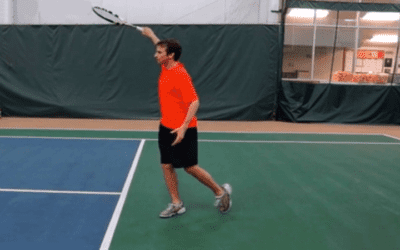Perform Anti-Rotation Exercises
It’s important to have a “go-to” tennis fitness exercise as part of your off court training.
A lot of players have some kind of training routine, but are probably doing the wrong kind exercises especially when it comes to strengthening the core.
A lot of people end up doing a lot of “rotation” type core exercises. They may help some, but I’m a big fan of performing doing “anti-rotation” core exercises that teaches the body to feel more stable.
One tennis fitness exercise that helps you stabilize your body in the most efficient manner is the Pallof Press.
Create Stability In Your Core Like Nadal
Use this tennis fitness exercise routine instead of rotation type exercises where you mimic swinging a racquet will give you much better results.
If you look at Rafa Nadal reaching out for wide balls, you’ll notice that he can flick a very powerful shot back without rotating his body. Instead he focuses on having tremendous stability through his core as he reaches out for the ball.
You can train the same way with your tennis fitness exercise adding the Paloff Press to your program.



While there may be value in your ‘core’ exercise, I totally disagree with the notion that the other resistance band exercises have little to no value — with the caveat that they are done correctly.
My resistance band exercises also include a strong component of core rotation management.
There’s three positions for resistance band exercise when using a door jam — top of door for slices; middle for flats and serves; and bottom for top spins. I’m using extra heavy duty single or combo bands at 35 lbs or more. I’ve customized my single extra heavy band by so it’s longer than the store bought bands — this allows a longer path of movement than typical regular bands provide. It’s important to be able to practice a long forward follow thru of your ground strokes — regular bands can inhibit this.
At the club, I’m using 30-40 lbs on the equipment high, mid, low. It’s great for a pre-match warmup.
My typical multiple band set is 50 lbs. It’s a real test of core strength AND knee strength…. (Not recommended for newbs!) Twentyfive topspin reps with the 50 lbs multiple bands leaves me as exhausted as a full out 20 stroke rally. Then I continue with flats and slices… Then switch to BHs.
With the forehand, it’s important to include the proper opposite arm movement in the ‘stroke’. Without the opposite arm moving across and tucking back to force the other arm forward, I struggle to move 25 lbs. With good opposite arm movement, I’m moving 35 or more lbs for 25 reps.
I’m also including knee bends — I use a mirror or window reflection and bend my knees to get below my eyes in the reflection below my standing shoulder height before starting forward stroke.
You are correct that it’s important not to tip your core to get low. I use a reference starting point of putting my arm to my knee so they create a perpendicular line from the floor to my shoulder. This reference of quickly touching your knee to make a vertical line to the ground to your shoulder also works during play to set a repeatable reference point. This may be easy for short folks to ignore but as an over six footer, staying low in a repeatable position is a constant problem. When my game is going south, I find this is frequently a good place to start getting my core sorted out.
I finish moving upwards during the resistance stroke, keeping the core stable with good opposite arm movement. It’s also important to look the imaginary ball into the strike zone and beyond. I typically practice bands in open stance, as well as closed, plus open stance with a forward step and open stance with a leg push from the outside back to the center to give topspin as well as some side spin, while also initiating movement to the court center for the returned ball.
For slices, the key is to have good level opposite arm rotation across the net to keep your core during the downward stroke. Backhand slice are similar, but require more pre-stroke shoulder rotation before initiating the stroke.
Backhands — I’m practicing both single and two handed in all three positions. Typically, I’m playing with two handed backhands for topspins and flats, with one handed slice. However, there’s occasion when I’ll toss in a one handed flat or topspin, just to keep opponents off balance. The key for one handed flat and topspin backhands is to use your opposite arm as your core’s pivot point as if it’s on a low fence post. This provides a long stroke with power coming from your shoulders.
I also use the mid door position for service practice starting with the trophy pose with my opposite arm, then pulling it down as the service arm moves up. Being 6’1″, my service hand reaches the ceiling at max height, which also makes for a good repeatable location. FYI, as a 63 yr old geezer, my serves frequently exceed 100 mph (measured by pro device), and I’ve got the whole spin package from slice to top to twist plus flat.
———-
Anyways, don’t get me wrong. I’m open and curious as an avid resistant band user to try what you suggest. However, it seems to be more of a core strength building exercise, rather than muscle memory and core strength exercise that I’ve using with success for a number of years. But I’m open to see how it works out.
I suspect that as an antique HS All-american swimmer and D1 college water polo player (played WP vs Spitz in HS, couple swim club teammates won Olympic gold medals), I’ve got a significantly more developed core posture than most. The exercise you describe may have high value to folks with weak cores and I’m sure there are plenty of those folks around. High end swimming and Water Polo is all about having a strongly controlled powerful core rotation, so I’m not sure of it’s validity for me. But I’ll see…
Fred, Your exercises may work for you and otters, but I do not think players should practice there strokes using resistance.
Should the Pallof press be performed on both sides? I.e. alternating sets, for instance, one set with the band attached away to the right and one set with the band attached away to the left?
Regards
Yes Ian, Work both sides!